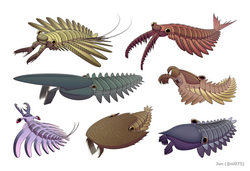| Cambroraster Temporal range: Mid Cambrian: | |
|---|---|
 | |
| Fossil of a Cambroraster head sclerite (ROMIP 65079) | |
| Video animation | |
| Scientific classification | |
| Kingdom: | Animalia |
| Phylum: | Arthropoda |
| Class: | † Dinocaridida |
| Order: | † Radiodonta |
| Family: | † Hurdiidae |
| Subfamily: | † Hurdiinae |
| Genus: | † Cambroraster |
| Type species | |
| Cambroraster falcatus Moysiuk & Caron, 2019 | |
| Species | |
| |

Cambroraster is an extinct monotypic genus of hurdiid radiodont, dating to the middle Cambrian, and represented by the single formally described species Cambroraster falcatus. [1] Hundreds of specimens were found in the Burgess Shale, and described in 2019. [2] A large animal (for its era) at up to 30 centimetres (12 in) (but not as long as Titanokorys at 50 centimetres (20 in)), it is characterized by a significantly enlarged horseshoe-shaped dorsal carapace (H-element), and presumably fed by sifting through the sediment with its well-developed tooth plates (oral cone) and short frontal appendages with hooked spines. [1] Nicknamed the "spaceship" fossil when first found, for the way its dorsal carapace resembles the fictional Millennium Falcon, the specific epithet falcatus in its scientific name is a nod to that resemblance. [1] [3] [4]
Contents
- Reconstruction
- Head sclerites
- Frontal appendage
- Movement range of the frontal appendage
A second species of Cambroraster is known from the Chengjiang Biota of South China, making it the first uncontroversial hurdiid from the Cambrian of China. This species is known only from a juvenile dorsal carapace, so it was not given a specific name. [5]
Although originally suggested to have used its frontal appendages to sift sediment for prey, a later study by different authors suggested that it may have been a filter feeder instead. [6]




